五级乐理考试(英国皇家音乐学院)
英皇乐理考级1-5级
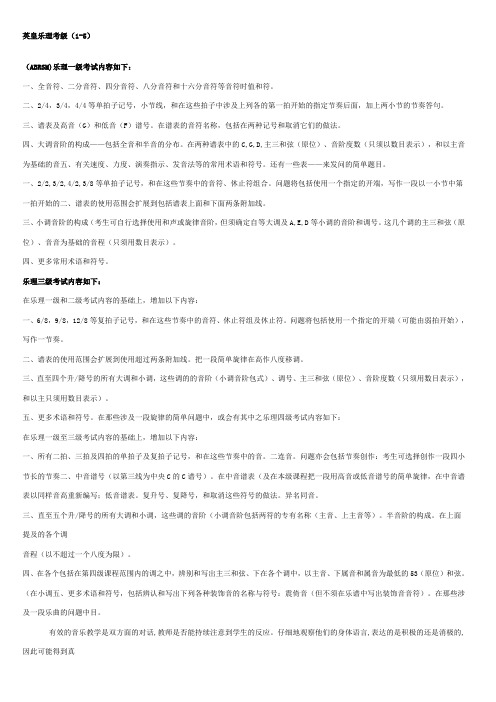
英皇乐理考级(1-5)(ABRSM)乐理一级考试内容如下:一、全音符、二分音符、四分音符、八分音符和十六分音符等音符时值和符。
二、2/4,3/4,4/4等单拍子记号,小节线,和在这些拍子中涉及上列各的第一拍开始的指定节奏后面,加上两小节的节奏答句。
三、谱表及高音(G)和低音(F)谱号。
在谱表的音符名称,包括在两种记号和取消它们的做法。
四、大调音阶的构成——包括全音和半音的分布。
在两种谱表中的C,G,D,主三和弦(原位)、音阶度数(只须以数目表示),和以主音为基础的音五、有关速度、力度、演奏指示、发音法等的常用术语和符号。
还有一些表——来发问的简单题目。
一、2/2,3/2,4/2,3/8等单拍子记号,和在这些节奏中的音符、休止符组合。
问题将包括使用一个指定的开端,写作一段以一小节中第一拍开始的二、谱表的使用范围会扩展到包括谱表上面和下面两条附加线。
三、小调音阶的构成(考生可自行选择使用和声或旋律音阶,但须确定自等大调及A,E,D等小调的音阶和调号。
这几个调的主三和弦(原位)、音音为基础的音程(只须用数目表示)。
四、更多常用术语和符号。
乐理三级考试内容如下:在乐理一级和二级考试内容的基础上,增加以下内容:一、6/8,9/8,12/8等复拍子记号,和在这些节奏中的音符、休止符组及休止符。
问题将包括使用一个指定的开端(可能由弱拍开始),写作一节奏。
二、谱表的使用范围会扩展到使用超过两条附加线。
把一段简单旋律在高作八度移调。
三、直至四个升/降号的所有大调和小调,这些调的的音阶(小调音阶包式)、调号、主三和弦(原位)、音阶度数(只须用数目表示),和以主只须用数目表示)。
五、更多术语和符号。
在那些涉及一段旋律的简单问题中,或会有其中之乐理四级考试内容如下:在乐理一级至三级考试内容的基础上,增加以下内容:一、所有二拍、三拍及四拍的单拍子及复拍子记号,和在这些节奏中的音。
二连音。
问题亦会包括节奏创作:考生可选择创作一段四小节长的节奏二、中音谱号(以第三线为中央C的C谱号)。
2021 英皇乐理 五级 a卷

在2021年英皇乐理五级A卷考试中,学生们将接受一项独特的考验,涵盖了音乐理论的深度和广度。
在这篇文章中,我们将深入探讨这份考卷的内容,并就其中涉及的音乐理论知识进行全面评估,帮助读者更好地理解和掌握相关知识。
一、音程2021年英皇乐理五级A卷考试中将对音程进行深入浅出的讨论。
音程是音乐理论中的基本概念之一,是指两个音的音高之差。
在考试中,学生需要对各种不同类型的音程进行准确的识别和理解,包括纯音程、大、小、增、减音程等。
在文章中,我们将结合具体示例,对音程的概念和特点进行详细介绍,帮助读者更好地理解这一重要知识点。
二、节奏除了音程外,2021年英皇乐理五级A卷考试还将涉及节奏的相关内容。
节奏在音乐中占据着重要的地位,它决定了音乐的节奏感和韵律感。
在考试中,学生需要对拍子、节拍、节奏型等概念有清晰的理解,并能够准确地进行节奏分析。
在文章的这一部分,我们将详细介绍节奏的相关知识,包括不同音符的时值、拍子的划分和节奏型的演示,以帮助读者全面掌握节奏的理论知识。
三、调式与音阶2021年英皇乐理五级A卷考试还将涉及调式和音阶的知识。
调式和音阶是音乐中的重要概念,对于理解音乐的结构和构成有着至关重要的作用。
在文章中,我们将介绍不同调式和音阶的构成方式、特点及其在音乐中的应用,帮助读者更好地理解这一部分内容。
总结与展望2021年英皇乐理五级A卷考试将对音程、节奏、调式和音阶等内容进行深度评估,要求学生具有扎实的音乐理论功底和较高的分析能力。
通过本文的介绍和分析,相信读者对这份考卷的内容有了更清晰的认识和理解。
我相信,只有深入理解音乐理论,才能在考试中取得优异的成绩,更好地理解和欣赏音乐。
作为音乐理论的写手,我对这一主题有着深刻的个人观点和理解。
音乐理论不仅是一门学科,更是一种艺术的表达方式和思维方式。
通过学习音乐理论,我们可以更深入地理解音乐的内在结构和美学特点,从而提升我们对音乐的欣赏和理解能力。
希望本文能够帮助读者更好地理解音乐理论的重要性和魅力所在。
英皇钢琴五级考级大纲英文版la chevaleresque
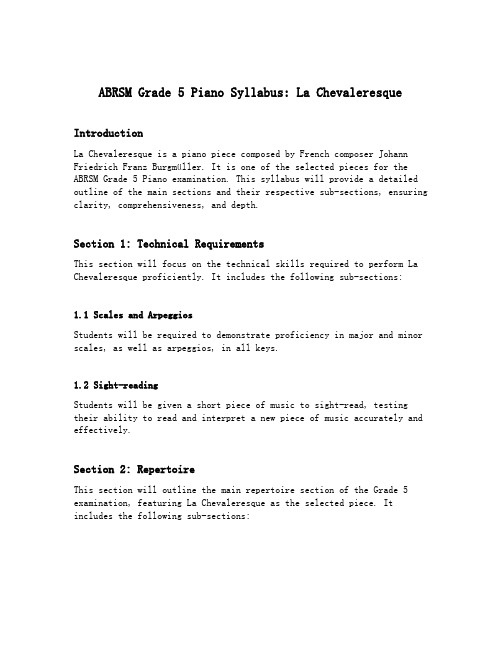
ABRSM Grade 5 Piano Syllabus: La ChevaleresqueIntroductionLa Chevaleresque is a piano piece composed by French composer Johann Friedrich Franz Burgmüller. It is one of the selected pieces for the ABRSM Grade 5 Piano examination. This syllabus will provide a detailed outline of the main sections and their respective sub-sections, ensuring clarity, comprehensiveness, and depth.Section 1: Technical RequirementsThis section will focus on the technical skills required to perform La Chevaleresque proficiently. It includes the following sub-sections:1.1 Scales and ArpeggiosStudents will be required to demonstrate proficiency in major and minor scales, as well as arpeggios, in all keys.1.2 Sight-readingStudents will be given a short piece of music to sight-read, testing their ability to read and interpret a new piece of music accurately and effectively.Section 2: RepertoireThis section will outline the main repertoire section of the Grade 5 examination, featuring La Chevaleresque as the selected piece. It includes the following sub-sections:2.1 La Chevaleresque - J ohann Friedrich Franz BurgmüllerStudents are expected to perform La Chevaleresque with precision and musicality. The piece consists of the following parts:2.1.1 IntroductionThe introduction sets the tone and mood of the piece, establishing a playful and adventurous atmosphere.2.1.2 Theme 1Theme 1 is characterized by its energetic and lively melody. The student should emphasize the dynamic contrasts and articulation nuances.2.1.3 TransitionThe transition serves as a bridge between Theme 1 and Theme 2. Students should pay attention to the phrasing and continuity during this section.2.1.4 Theme 2Theme 2 presents a contrasting melody to Theme 1, showcasing a more lyrical and expressive character. The student should highlight the melodic shape and use of dynamics.2.1.5 CodaThe coda brings the piece to a satisfying conclusion, with a final flourish. The student must maintain control and clarity throughout this section.2.2 Additional RepertoireIn addition to La Chevaleresque, students must also prepare and perform two contrasting pieces from the Grade 5 repertoire list provided by ABRSM. These pieces will test their ability to interpret different musical styles and genres.Section 3: Music TheoryThis section will cover the theoretical aspects necessary for the Grade 5 examination. It includes the following sub-sections:3.1 General KnowledgeStudents should demonstrate a good understanding of scales, modes, and ornamentation. They should be able to identify and define key musical terms related to La Chevaleresque and other pieces.3.2 Aural SkillsStudents will be assessed on their ability to recognize and identify melodic and harmonic intervals, chords, and cadences. They should also be able to sight-sing a given melody.3.3 Sight-singingStudents will be given a short melody to sight-sing, testing theirability to accurately reproduce pitch and rhythm.3.4 Score ReadingStudents will be required to analyze and interpret a musical score, demonstrating their understanding of key signatures, time signatures, and other notational elements.ConclusionThis syllabus provides a comprehensive and detailed outline of the ABRSM Grade 5 Piano examination, focusing on the piece “La Chevaleresque” by Johann Friedrich Franz Burgmüller. By mastering the technical requirements, performing the selected piece with musicality and precision, and demonstrating theoretical knowledge and skills, students will be well-prepared for the Grade 5 examination.。
英皇乐理5级练习题

英皇乐理5级练习题一、音值与节奏1 2 3 4 5 6 73 4 5 6 7 1 2××× ×× ×××× ×××× ×× ×× ×× ×× ××四分音符、八分音符、二分音符八分音符、十六分音符、全音符二、音程与和弦C到GD到AF到BC大三和弦F小和弦G增和弦CEGDFAGBD三、调式与调性1. 请写出C大调的音阶。
2. 请写出a小调的音阶。
CDEFGABCABCDEFGA四、旋律分析与创作×× ×× ×× ×× ×× ×× ×× ×× CDEFGABC(移至G大调)五、音乐术语与符号FortePianoAllegro连音线断音符号强音符号DynamicsTempoHarmony六、视唱练耳CDEFGABCGABCDEFGC大三和弦a小和弦G七和弦××× ×× ×××× ×××× ×× ×× ×× ×× ××七、和声分析C G Am Em F CC Major: C B CDEF E DF A C F D BG C八、乐曲分析贝多芬《命运交响曲》第一乐章巴赫《G弦上的咏叹调》莫扎特《土耳其进行曲》柴可夫斯基《四季》之《六月》贝多芬《月光奏鸣曲》第一乐章德沃夏克《新世界交响曲》第二乐章九、音乐史与风格1. 请简述巴洛克时期的音乐特点。
英皇钢琴考级乐理1-5级内容
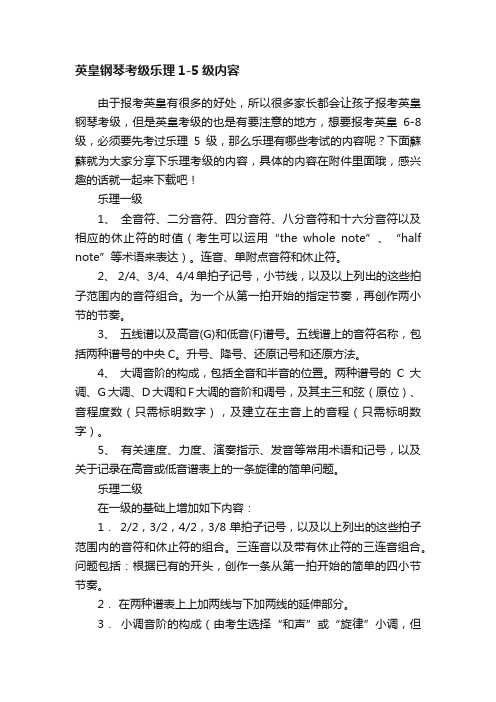
英皇钢琴考级乐理1-5级内容由于报考英皇有很多的好处,所以很多家长都会让孩子报考英皇钢琴考级,但是英皇考级的也是有要注意的地方,想要报考英皇6-8级,必须要先考过乐理5级,那么乐理有哪些考试的内容呢?下面蘇蘇就为大家分享下乐理考级的内容,具体的内容在附件里面哦,感兴趣的话就一起来下载吧!乐理一级1、全音符、二分音符、四分音符、八分音符和十六分音符以及相应的休止符的时值(考生可以运用“the whole note”、“half note”等术语来表达)。
连音、单附点音符和休止符。
2、 2/4、3/4、4/4单拍子记号,小节线,以及以上列出的这些拍子范围内的音符组合。
为一个从第一拍开始的指定节奏,再创作两小节的节奏。
3、五线谱以及高音(G)和低音(F)谱号。
五线谱上的音符名称,包括两种谱号的中央C。
升号、降号、还原记号和还原方法。
4、大调音阶的构成,包括全音和半音的位置。
两种谱号的C大调、G大调、D大调和F大调的音阶和调号,及其主三和弦(原位)、音程度数(只需标明数字),及建立在主音上的音程(只需标明数字)。
5、有关速度、力度、演奏指示、发音等常用术语和记号,以及关于记录在高音或低音谱表上的一条旋律的简单问题。
乐理二级在一级的基础上增加如下内容:1.2/2,3/2,4/2,3/8单拍子记号,以及以上列出的这些拍子范围内的音符和休止符的组合。
三连音以及带有休止符的三连音组合。
问题包括:根据已有的开头,创作一条从第一拍开始的简单的四小节节奏。
2.在两种谱表上上加两线与下加两线的延伸部分。
3.小调音阶的构成(由考生选择“和声”或“旋律”小调,但希望考生知道他们所选择的是哪一种形式)。
A大调、降B大调和降E 大调以及A小调、E小调和D小调的音阶与调号,及其主三和弦(原位)、音程度数(只需标明数字),以及建立在主音上的音程(只需标明数字)。
4.更多常用的术语和记号。
乐理三级在之前等级的基础上增加如下内容:1.6/8,9/8,12/8复拍子记号,以及以上列出的这些拍子范围内的音符和休止符的组合。
2023英皇五级乐理题

2023英皇五级乐理题一、音阶与调式1. 将下列调式标注上面在纯音阶和升记号中所属的音阶。
a) C调 natural - ________________b) F#调 mixolydian - ________________c) Ab调 dorian - _________________2. 将下列旋律中的下划线音符补全为与所给的调式相应的音阶音符。
a) E 调 natural,音符:E F# G A B C# D E F# G ______________b) D 调 harmonic minor,音符:D E F G A B ______________ C# Dc) A 调 melodic minor (ascending),音符:A B C D E F# G# A______________二、和弦与和声分析3. 根据下列和弦标注上面的类别和根音名称。
a) Cmaj7 - 类别:____________ 根音:____________b) F#dim - 类别:____________ 根音:____________c) G7sus4 - 类别:____________ 根音:____________4. 下列音乐片段中的下划线部分是什么和弦类型?a) Cmaj7 - E ____________ G Bb) Dm - D ____________ F Ac) G7sus4 - C ____________ F G三、和声写作5. 根据给出的主和弦,选择适当的副和弦并用罗马数字记号表示。
a) 在C大调中,主和弦:E major,副和弦:____________b) 在A大调中,主和弦:B minor,副和弦:____________c) 在Eb大调中,主和弦:G minor,副和弦:____________6. 根据给定的主和弦和适当的九度和弦继续下面的小节。
a) 主和弦:G major,九度和弦:Gmaj9b) 主和弦:D minor,九度和弦:Dmin9c) 主和弦:E major,九度和弦:Emaj9四、旋律和节奏7. 将下列音乐片段标注上正确的节拍、音调和音值。
英皇五级乐理考点
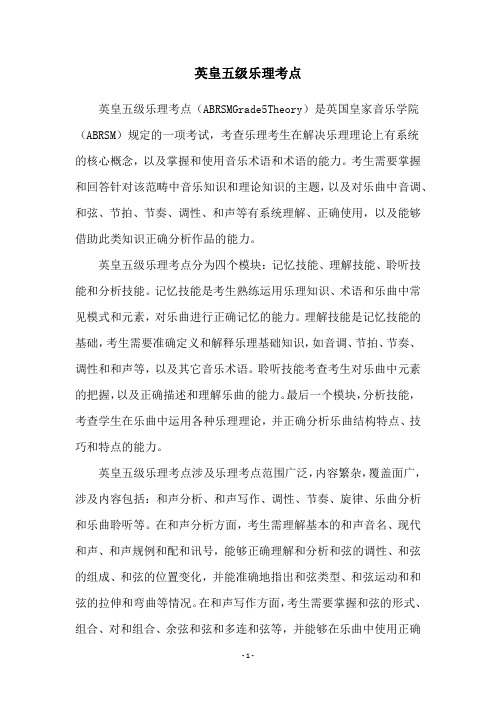
英皇五级乐理考点英皇五级乐理考点(ABRSMGrade5Theory)是英国皇家音乐学院(ABRSM)规定的一项考试,考查乐理考生在解决乐理理论上有系统的核心概念,以及掌握和使用音乐术语和术语的能力。
考生需要掌握和回答针对该范畴中音乐知识和理论知识的主题,以及对乐曲中音调、和弦、节拍、节奏、调性、和声等有系统理解、正确使用,以及能够借助此类知识正确分析作品的能力。
英皇五级乐理考点分为四个模块:记忆技能、理解技能、聆听技能和分析技能。
记忆技能是考生熟练运用乐理知识、术语和乐曲中常见模式和元素,对乐曲进行正确记忆的能力。
理解技能是记忆技能的基础,考生需要准确定义和解释乐理基础知识,如音调、节拍、节奏、调性和和声等,以及其它音乐术语。
聆听技能考查考生对乐曲中元素的把握,以及正确描述和理解乐曲的能力。
最后一个模块,分析技能,考查学生在乐曲中运用各种乐理理论,并正确分析乐曲结构特点、技巧和特点的能力。
英皇五级乐理考点涉及乐理考点范围广泛,内容繁杂,覆盖面广,涉及内容包括:和声分析、和声写作、调性、节奏、旋律、乐曲分析和乐曲聆听等。
在和声分析方面,考生需理解基本的和声音名、现代和声、和声规例和配和讯号,能够正确理解和分析和弦的调性、和弦的组成、和弦的位置变化,并能准确地指出和弦类型、和弦运动和和弦的拉伸和弯曲等情况。
在和声写作方面,考生需要掌握和弦的形式、组合、对和组合、余弦和弦和多连和弦等,并能够在乐曲中使用正确的和声符号。
调性方面,考生需要正确理解不同调性的定义、写法、用法,并能准确地指出调性的基调、小调和旋律等情况,以及调性的运动和变化。
节奏方面,考生需要掌握基本的音符和步骤、快步和慢步的定义,以及节奏的转换、变化和复杂节奏的分析。
旋律分析方面,要求考生正确理解旋律成分、大小调、结构和特点,以及乐曲中特定旋律段落的分析。
最后,乐曲分析和乐曲聆听类考点,要求考生结合前面所学乐理知识,准确理解乐曲的运动和变化,并分析乐曲结构特点和技法特点。
英国皇家音乐学院五级乐理考试分析

英国皇家音乐学院五级乐理考试分析摘要笔者多年从事英国皇家音乐学院乐理部分的教学工作,对于其中的内容翻译作出理解和分析,并加以整理和选择,就英国皇家音乐学院考级中的五级乐理考试内容,进行详细的说明,同时给考级的考生及家长一些建议和笔者本人的一些思考。
[关键词]英国皇家音乐学院(简称“英皇”);考级;聆听近年,随着钢琴的普及化教育,考级也逐渐升温,不仅为家长圆了钢琴梦的孩子们,提供一个证明自己的机会,同时也提高了全国钢琴的水平。
在国家音协的考级如火如荼的同时,令一个新兴的考级悄然进入了中国大陆地区——英国皇家音乐考级,这项考级囊括了所有乐器及声乐的考级,与国家音协大致相同,只是略有不同,其中五级以上(不包括五级)的考级需要先通过其五级乐理的理论笔试,满分100分,及格为66分。
下面就笔者对于这几年的教学做将英皇五级乐理的内容,与国内乐理进行简单比较说明,并给考级的家长和考生们一些小的建议:首先,没有扎实的专业理论基础,不大好理解英皇乐理的内容,而造成这种的原因有二:一是两国的文化差异,我们拿到的都是翻译的版本,译者是长期接触英国文化的,这在理解和学习过程中无疑会产生差异和我误解;二是细分两种乐理之间的差异,其中不论从概念定义上,还是从内容标记上都有着或多或少的差异。
那么我们来看看有哪些内容会造成这种情况:音程部分:在英皇从二级开始教授,起初是最为简单的度数计算,与我国的乐理毫无冲突;三级开始计算具体的音程,实际上就是中国乐理中的自然音程,并没有详细指出几个半音几个全音的计算方式,在翻译上只是说从哪个音到哪个音是多上度的具体名称,并没说明为什么这两个音之间叫这个名称;在之后的增减音程,也就是变化音程,说的倒是与中国乐理所指明的内容相仿,但在自然音程部分就开始模糊了,学生难免更难理解,那么也就不用说后面五级所教授的复音程了。
其次,就我们一些专业课教师而言,所采用的任然是中国的乐理讲授方式和内容,这就使得学生会产生误解,不明就里,分不清哪一种是正确的。
五级乐理考试(英国皇家音乐学院)
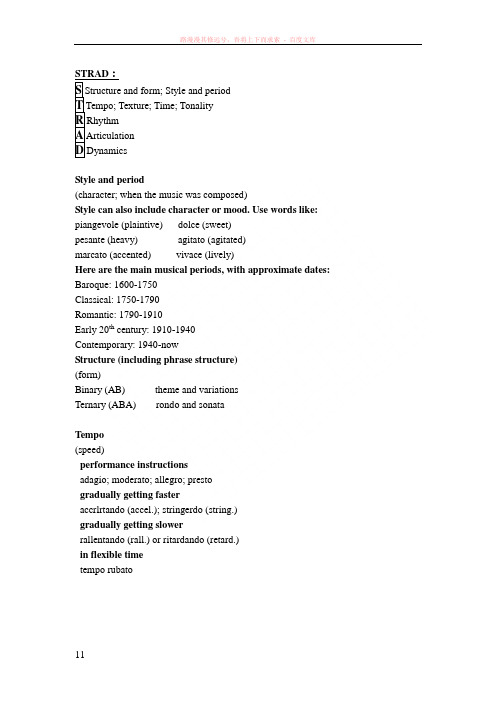
Style and period
Contemporary: 1940-now
Structure (including phrase structure)
(form)
Binary (AB)
theme and variations
Ternary (ABA) rondo and sonata
Tempo (speed) performance instructions adagio; moderato; allegro; presto gradually getting faster accrlrtando (accel.); stringerdo (string.) gradually getting slower rallentando (rall.) or ritardando (retard.) in flexible time tempo rubato
11
路漫漫其修远兮,吾将上下而求索 - Texture (think in terms of thick or thin) Homophonic: chordal, medlody usually in the upper part with chords or broken chords in the lower part Contrapuntal: two or more melodic lines of equal importance combined together Time Number of beats in a bar (2, 3 or 4); simple or compound Tonality major, minor, modal or atonal Rhythm (the pattern of note values) Regular or irregular; describe rhythmic figures (e.g. dotted rhythm, triplets, syncopation) Articulation detached, smooth, accented or ornamented Dynamics (loud/quiet, gradually getting louder/quieter) mf; f; ff; mp; p; pp; crescendo; diminusndo
英皇乐理5级考试流程
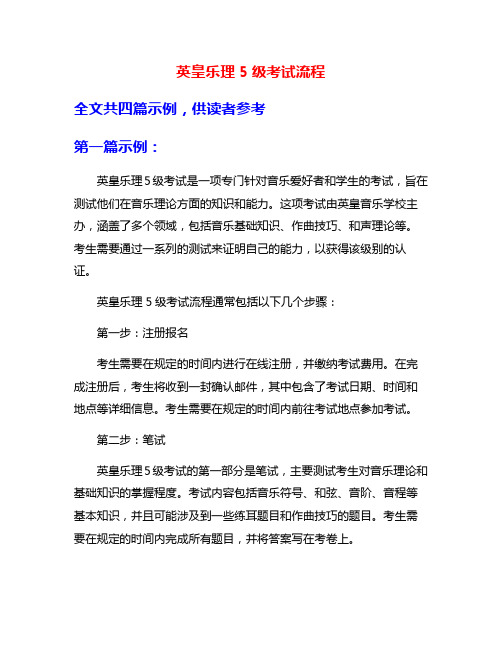
英皇乐理5级考试流程全文共四篇示例,供读者参考第一篇示例:英皇乐理5级考试是一项专门针对音乐爱好者和学生的考试,旨在测试他们在音乐理论方面的知识和能力。
这项考试由英皇音乐学校主办,涵盖了多个领域,包括音乐基础知识、作曲技巧、和声理论等。
考生需要通过一系列的测试来证明自己的能力,以获得该级别的认证。
英皇乐理5级考试流程通常包括以下几个步骤:第一步:注册报名考生需要在规定的时间内进行在线注册,并缴纳考试费用。
在完成注册后,考生将收到一封确认邮件,其中包含了考试日期、时间和地点等详细信息。
考生需要在规定的时间内前往考试地点参加考试。
第二步:笔试英皇乐理5级考试的第一部分是笔试,主要测试考生对音乐理论和基础知识的掌握程度。
考试内容包括音乐符号、和弦、音阶、音程等基本知识,并且可能涉及到一些练耳题目和作曲技巧的题目。
考生需要在规定的时间内完成所有题目,并将答案写在考卷上。
笔试结束后,考生将进行口试环节。
在口试中,考生将面对一位考官,根据考官的要求回答问题或展示自己的音乐技能。
口试内容可能包括乐谱分析、和声练习、音程练习等,考生需要根据考官的要求准确地演示。
第四步:实践考试英皇乐理5级考试还包括一项实践考试,此项考试主要是为了测试考生在作曲和和声方面的能力。
考生需要根据考官的要求即兴创作一段音乐,或者根据给定的乐谱进行演奏。
考生需要在规定的时间内完成考试,并展示自己的音乐才华。
第五步:总结考试结束后,考官将根据笔试、口试和实践考试的成绩综合评定考生的能力。
考生将根据综合得分来决定是否通过考试,并获得英皇乐理5级认证。
考生可以通过官方网站查询考试成绩和证书颁发时间,以便及时了解考试结果。
第二篇示例:英皇乐理5级考试是英皇音乐学院在音乐理论方面的一项考试,旨在评估考生对音乐理论知识的掌握程度和应用能力。
考试内容涵盖音乐基本概念、音乐符号、调性、和声、曲式等方面,考试形式以笔试为主,部分考场可能有视唱练耳的要求。
英国皇家音乐学院钢琴专业科目测评的具体内容(1-8

英国皇家⾳乐学院钢琴专业科⽬测评的具体内容(1-8 级考级)在英国皇家⾳乐学院1-8 级的各项专业科⽬考级中,⼏乎都要选择三⾸风格各异的⾳乐作品,⽽这些作品则来⾃于实现由英国皇家⾳乐学院联合会所公布的最新⼀期的详细曲⽬清单之中。
此外还要加试⾳阶、琶⾳;视奏以及听⼒测试。
所有这些内容由参考者⾃⼰决定演奏的顺序。
演奏考试内容:1.基本技能:⾳阶、琶⾳以及和弦2.理论:基础知识,应⽤3.视奏:快速学习能⼒的综合测试4.视唱及听⼒:视唱,节奏,练⽿5.⾳乐理解:理论实践欣赏名段并说出该段的风格,表现⼿法,及哪个时期和谁的作品等⼀、钢琴考级演奏曲⽬的选择:由于英国皇家⾳乐学院的考级⼤纲是公开的,所以决定了由这个委员会所制定的考级曲⽬必须能够涵盖当今世界上的各类⾳乐形式与风格,以及各个时期和不同地域和不同作曲家的各类作品。
因此可以说是五花⼋门,⼗分⼴泛。
不过其中的思路还是令⼈⼀⽬了然。
通常在欧洲的⾳乐史论中把近现代⾳乐⼤致分为巴洛克时期、古典时期、罗曼蒂克时期以及⼆⼗世纪的⾳乐四⼤类不同的时期与风格。
所以在演奏考试的曲⽬选择分为三个部分:1、通常是巴洛克⾳乐和古典⾳乐2、以⼤量的浪漫派⾳乐和各类民族乐派代表⼈物的作品3、⼆⼗世纪以后的各种现代的、各国家民族的、先锋派的、爵⼠乐以及拉丁⾳乐等有代表性的⾳乐其中以第⼀部分为例,由于巴洛克时期的⾳乐⼤都以复调⾳乐形式为主,因此常常还会发现像肖斯塔科维奇以及亨德⽶茨的前奏曲与赋格等这样的现代作品,因此可以说成是巴洛克式样的复调性质的⾳乐。
由此可见其曲⽬的风格分类⽅式⼜如其图书馆的分类⽅式⼀样,尽管有着许多交叉与覆盖,是既考虑周密⽽⼜详尽。
以下曲⽬是 2002 年⾄2003 年度由英国皇家⾳乐学院联合会所颁布的1-8 级钢琴专业考试具体曲⽬范围,曲⽬范围分为A、B、C 三组,考⽣必须选择每组中的⼀⾸作品作为考试演奏曲⽬。
由于考虑到⼀些⽂字的翻译可能会引起⼀些误解,所以尽量保留了原始的⽂字以供参考,⽽对于国内⽐较熟悉的作曲家和作品则采⽤了惯⽤的名称,其中⼤部分参考了外国曲名字典和⾳乐词典等国内常⽤的⾳乐⼯具书。
【免费下载】英国皇家音乐学院考级指南
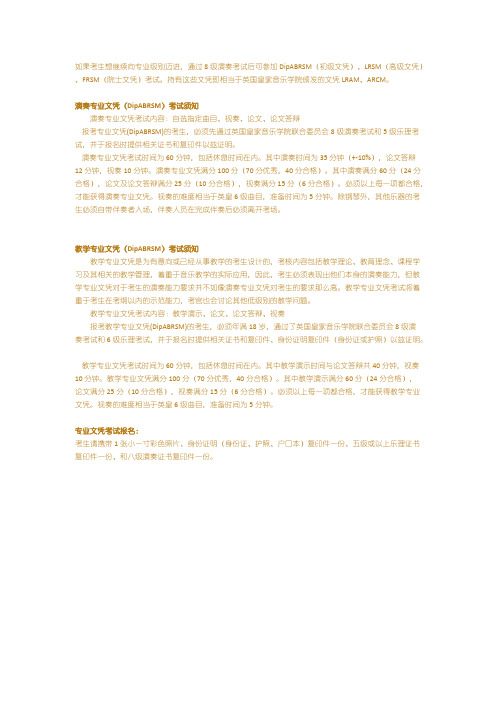
如果考生想继续向专业级别迈进,通过8级演奏考试后可参加DipABRSM(初级文凭)、LRSM(高级文凭)、FRSM(院士文凭)考试。
持有这些文凭即相当于英国皇家音乐学院颁发的文凭LRAM、ARCM。
演奏专业文凭(DipABRSM)考试须知 演奏专业文凭考试内容:自选指定曲目、视奏、论文、论文答辩报考专业文凭(DipABRSM)的考生,必须先通过英国皇家音乐学院联合委员会8级演奏考试和5级乐理考试,并于报名时提供相关证书和复印件以兹证明。
演奏专业文凭考试时间为60分钟,包括休息时间在内。
其中演奏时间为35分钟(+-10%),论文答辩12分钟,视奏10分钟。
演奏专业文凭满分100分(70分优秀,40分合格)。
其中演奏满分60分(24分合格),论文及论文答辩满分25分(10分合格),视奏满分15分(6分合格)。
必须以上每一项都合格,才能获得演奏专业文凭。
视奏的难度相当于英皇6级曲目,准备时间为5分钟。
除钢琴外,其他乐器的考生必须自带伴奏者入场,伴奏人员在完成伴奏后必须离开考场。
教学专业文凭(DipABRSM)考试须知 教学专业文凭是为有意向或已经从事教学的考生设计的,考核内容包括教学理论、教育理念、课程学习及其相关的教学管理,着重于音乐教学的实际应用,因此,考生必须表现出他们本身的演奏能力,但教学专业文凭对于考生的演奏能力要求并不如像演奏专业文凭对考生的要求那么高。
教学专业文凭考试将着重于考生在考纲以内的示范能力,考官也会讨论其他低级别的教学问题。
教学专业文凭考试内容:教学演示、论文、论文答辩、视奏 报考教学专业文凭(DipABRSM)的考生,必须年满18岁,通过了英国皇家音乐学院联合委员会8级演奏考试和6级乐理考试,并于报名时提供相关证书和复印件、身份证明复印件(身份证或护照)以兹证明。
教学专业文凭考试时间为60分钟,包括休息时间在内。
其中教学演示时间与论文答辩共40分钟,视奏10分钟。
教学专业文凭满分100分(70分优秀,40分合格)。
英皇乐理五级

1、判断巴松管是移调乐器巴松管是标准管弦乐团木管乐组成员,写出标准管弦乐团另一个级别及该组别最低音的乐器名称组别:乐器:2、按人声音域,将以下声部由最低到最高排列:女低音男高音男中音女高音男低音完成下列句子的填充:次中音长号/伸缩号是标准管弦乐团组的成员一件偶然采用次中音谱号的标准管弦乐团木管乐器是一件采用中间谱号的标准管弦乐团弦乐器是3、一首曲子的最低音是小字一组的F,最高音是小字二组的A,在下列清单中,选出一件能够以相同音高奏出本曲子的乐器,在其下面划上横线巴松管/低音管双簧管低音大提琴长号/伸缩号定音鼓这件乐器属于管弦乐团哪个级别?4、一首曲子的最低音是小字一组的E,最高音是小字二组的B,请写出一件能够以相同音高奏出这曲子的管弦乐团乐器名称及所属组别乐器组别以上所选择的乐器是移调乐器还是非移调乐器。
5、一首曲子最高音是小字一组的E, 最低音是大字组的B,在下列清单中,选出一件以相同音高奏出本曲子的乐器,在其下面划横线,写出这件乐器所属的管弦乐团的组别名称长笛大提琴小鼓双簧管组别写出标准管弦乐团另一个不同组别,以及该级别最低音的乐器名称组别乐器6、一首曲子最高音是小字二组的G, 最低音是小字组的B,在下列清单中,选出一件以相同音高奏出本曲子的乐器,在其下面划横线巴松管/低音管低音大提琴长号/伸缩号单簧管写出与上题答案不同的标准管弦乐团组别,以及该级别最低音的乐器名称组别乐器7、从选段可见:巴松管/低音管会采用次中音谱号和低音谱号,写出在标准管弦乐团弦乐组一件也采用这两个谱号的乐器名称:乐器在下列清单中,选出一件能够以相同音高奏出第五至第十一小节巴松管/低音管声部的乐器,在其下画上横线。
单簧管小号中提琴长号/伸缩号这件乐器属于标准管弦乐团哪个组别写出两件标准管弦乐团敲击乐组别的乐器名称,一件可以奏出指定音高,另一件不能奏出指定音高指定音高没有指定音高8、选段是为男高音而写的。
写出音域介乎男高音与男低音之间的声乐声部名称在下列清单中,选出一件能够以相同音高奏出本选段钢琴左手声部,第三至第五小节的乐器,在其下画上横线双簧管小号中提琴巴松管/低音管这件乐器属于管弦乐团哪个组别?写出与上题答案不同的标准管弦乐团组别,以及该级别最低音的乐器名称组别乐器。
英国皇家音乐学院考级指南
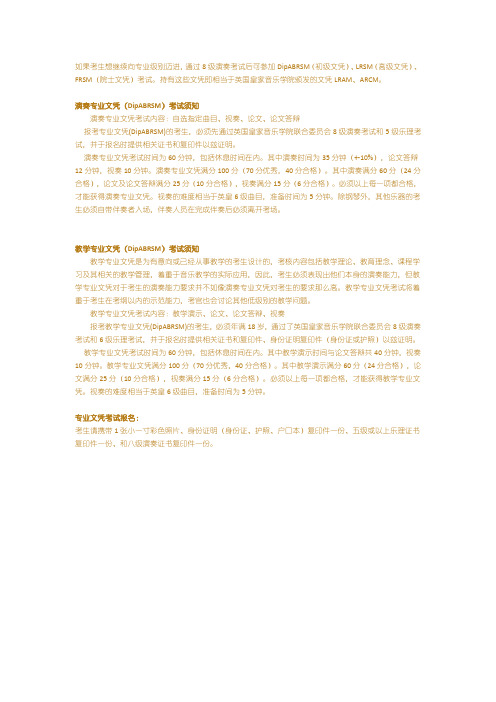
如果考生想继续向专业级别迈进,通过8级演奏考试后可参加DipABRSM(初级文凭)、LRSM(高级文凭)、FRSM(院士文凭)考试。
持有这些文凭即相当于英国皇家音乐学院颁发的文凭LRAM、ARCM。
演奏专业文凭(DipABRSM)考试须知演奏专业文凭考试内容:自选指定曲目、视奏、论文、论文答辩报考专业文凭(DipABRSM)的考生,必须先通过英国皇家音乐学院联合委员会8级演奏考试和5级乐理考试,并于报名时提供相关证书和复印件以兹证明。
演奏专业文凭考试时间为60分钟,包括休息时间在内。
其中演奏时间为35分钟(+-10%),论文答辩12分钟,视奏10分钟。
演奏专业文凭满分100分(70分优秀,40分合格)。
其中演奏满分60分(24分合格),论文及论文答辩满分25分(10分合格),视奏满分15分(6分合格)。
必须以上每一项都合格,才能获得演奏专业文凭。
视奏的难度相当于英皇6级曲目,准备时间为5分钟。
除钢琴外,其他乐器的考生必须自带伴奏者入场,伴奏人员在完成伴奏后必须离开考场。
教学专业文凭(DipABRSM)考试须知教学专业文凭是为有意向或已经从事教学的考生设计的,考核内容包括教学理论、教育理念、课程学习及其相关的教学管理,着重于音乐教学的实际应用,因此,考生必须表现出他们本身的演奏能力,但教学专业文凭对于考生的演奏能力要求并不如像演奏专业文凭对考生的要求那么高。
教学专业文凭考试将着重于考生在考纲以内的示范能力,考官也会讨论其他低级别的教学问题。
教学专业文凭考试内容:教学演示、论文、论文答辩、视奏报考教学专业文凭(DipABRSM)的考生,必须年满18岁,通过了英国皇家音乐学院联合委员会8级演奏考试和6级乐理考试,并于报名时提供相关证书和复印件、身份证明复印件(身份证或护照)以兹证明。
教学专业文凭考试时间为60分钟,包括休息时间在内。
其中教学演示时间与论文答辩共40分钟,视奏10分钟。
教学专业文凭满分100分(70分优秀,40分合格)。
英国皇家音乐学院考级简介
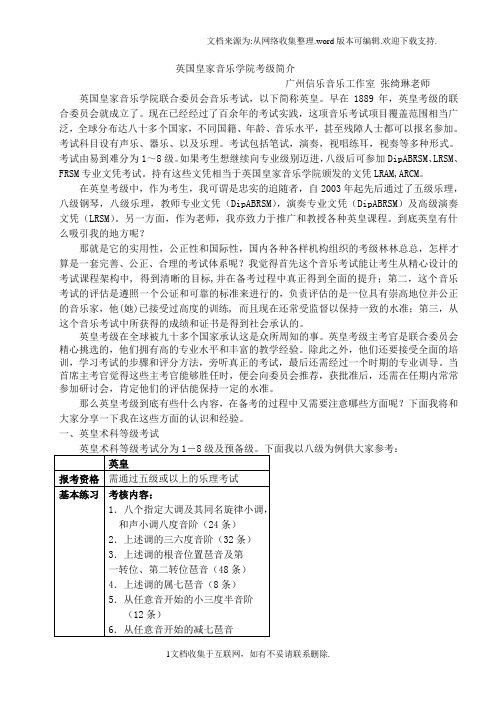
英国皇家音乐学院考级简介广州信乐音乐工作室张绮琳老师英国皇家音乐学院联合委员会音乐考试,以下简称英皇。
早在1889年,英皇考级的联合委员会就成立了。
现在已经经过了百余年的考试实践,这项音乐考试项目覆盖范围相当广泛,全球分布达八十多个国家,不同国籍、年龄、音乐水平,甚至残障人士都可以报名参加。
考试科目设有声乐、器乐、以及乐理。
考试包括笔试,演奏,视唱练耳,视奏等多种形式。
考试由易到难分为1~8级。
如果考生想继续向专业级别迈进,八级后可参加DipABRSM、LRSM、FRSM专业文凭考试。
持有这些文凭相当于英国皇家音乐学院颁发的文凭LRAM,ARCM。
在英皇考级中,作为考生,我可谓是忠实的追随者,自2003年起先后通过了五级乐理,八级钢琴,八级乐理,教师专业文凭(DipABRSM),演奏专业文凭(DipABRSM)及高级演奏文凭(LRSM)。
另一方面,作为老师,我亦致力于推广和教授各种英皇课程。
到底英皇有什么吸引我的地方呢?那就是它的实用性,公正性和国际性,国内各种各样机构组织的考级林林总总,怎样才算是一套完善、公正、合理的考试体系呢?我觉得首先这个音乐考试能让考生从精心设计的考试课程架构中, 得到清晰的目标,并在备考过程中真正得到全面的提升;第二,这个音乐考试的评估是遵照一个公证和可靠的标准来进行的,负责评估的是一位具有崇高地位并公正的音乐家,他(她)已接受过高度的训练, 而且现在还常受监督以保持一致的水准;第三,从这个音乐考试中所获得的成绩和证书是得到社会承认的。
英皇考级在全球被九十多个国家承认这是众所周知的事。
英皇考级主考官是联合委员会精心挑选的,他们拥有高的专业水平和丰富的教学经验。
除此之外,他们还要接受全面的培训,学习考试的步骤和评分方法,旁听真正的考试,最后还需经过一个时期的专业训导。
当首席主考官觉得这些主考官能够胜任时,便会向委员会推荐,获批准后,还需在任期内常常参加研讨会,肯定他们的评估能保持一定的水准。
2021 英皇乐理 五级 a卷
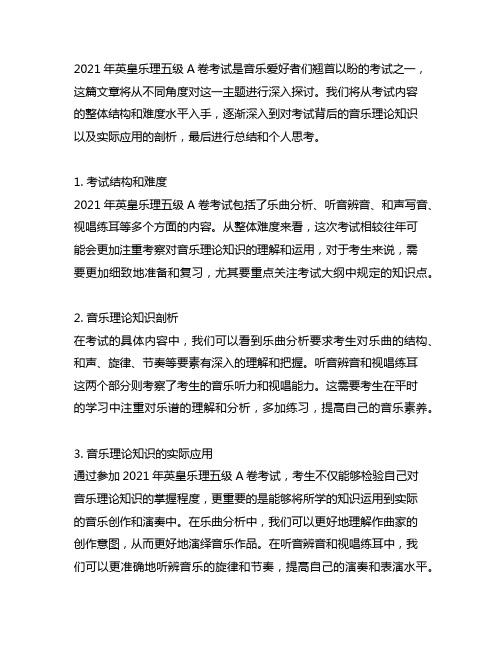
2021年英皇乐理五级A卷考试是音乐爱好者们翘首以盼的考试之一,这篇文章将从不同角度对这一主题进行深入探讨。
我们将从考试内容的整体结构和难度水平入手,逐渐深入到对考试背后的音乐理论知识以及实际应用的剖析,最后进行总结和个人思考。
1. 考试结构和难度2021年英皇乐理五级A卷考试包括了乐曲分析、听音辨音、和声写音、视唱练耳等多个方面的内容。
从整体难度来看,这次考试相较往年可能会更加注重考察对音乐理论知识的理解和运用,对于考生来说,需要更加细致地准备和复习,尤其要重点关注考试大纲中规定的知识点。
2. 音乐理论知识剖析在考试的具体内容中,我们可以看到乐曲分析要求考生对乐曲的结构、和声、旋律、节奏等要素有深入的理解和把握。
听音辨音和视唱练耳这两个部分则考察了考生的音乐听力和视唱能力。
这需要考生在平时的学习中注重对乐谱的理解和分析,多加练习,提高自己的音乐素养。
3. 音乐理论知识的实际应用通过参加2021年英皇乐理五级A卷考试,考生不仅能够检验自己对音乐理论知识的掌握程度,更重要的是能够将所学的知识运用到实际的音乐创作和演奏中。
在乐曲分析中,我们可以更好地理解作曲家的创作意图,从而更好地演绎音乐作品。
在听音辨音和视唱练耳中,我们可以更准确地听辨音乐的旋律和节奏,提高自己的演奏和表演水平。
总结和个人思考2021年英皇乐理五级A卷考试是一次全面考察音乐理论知识和实际应用能力的机会。
通过准备和参加这样的考试,不仅可以检验自己的音乐水平,更能够在学习和实践中不断提高,更好地享受音乐的魅力。
希望每一位参加考试的同学都能够用心准备,取得理想的成绩!通过本文的整体分析和探讨,读者可以更全面、深入地了解2021年英皇乐理五级A卷考试的内容和要求,以及为什么这样的考试对音乐爱好者来说意义重大。
通过对考试内容和实际应用的剖析,读者也可以更好地理解音乐理论知识的实际价值和应用意义。
希望本文对您有所帮助,期待您在考试中取得优异的成绩!音乐理论知识的学习和应用是音乐爱好者们不断追求的目标。
英皇乐理五级考试题型分析及注意要点

(一)在曲谱上加拍子记号(1)第一剖析是单拍子或复拍子(2)是规则拍子或不规则拍子(二)用不一样的谱号重写曲谱(1)注意不一样谱号中央 C的地点,不要写高或写低一个八度。
(2)记着加调号(3)注意审题,写哪段曲谱,原谱号是什么(三)描绘曲谱中的和声音程及旋律音程的名称(1)先看清曲谱的调号和同一小节的暂时记号再做出判断(2)是几度音程是不是复音程(3)判断是大小/增/减/纯音程(四)将开列总谱变为缩编谱,或将缩编谱变为开列总谱(1)书写要规整,符干的方向要切合规律,音距离显示音的时价。
(2)记着写调号及全部的暂时记号(3)缩编谱变为开列总谱注意男高音声部 [T],谱号的变化(低音谱号变高音谱号并在底部加 8),把音移高一个八度书写。
(五)音乐术语与演奏记号(1)熟记一些常用的速度、力度、音乐表现的术语(2)平常养成查阅音乐术语的好习惯(六)装修音短倚音 ;长倚音 ;上回音 ;下回音 ;颤音 ;上波音 ;下波音等常用装修音的写法和用法,在不一样期间作品中的不一样特色。
(七)用主 ,上主 ,部下 ,属描绘乐曲中的指定和弦,并指出低音声部是根音、三音仍是五音。
在谱表下用主46 及属 35 标出这两个和弦连续出现的地方。
(1)先看是什么调,找出这个调的主 ,上主 ,部下 ,属和弦,再看和弦的最底音是什么(2)找出这个调的主 46 及属 35 是什么音,判断它最底音是什么。
标出这两个和弦连续出现的地方。
(八)用倍全音符写出指定音符的同音异名注意审题是哪个声部什么地点(九)专出名词主/上主/中/部下/属/下中/导注意审题是哪个调哪个音(十)全部管弦乐团乐器名称,所属组别及其音域管乐/弦乐/敲击乐/木管/铜管/有固定音高/无固定音高/长笛/小号/小提琴/钢片琴/小鼓/单簧管/长号/中提琴/双簧管/圆号/大提琴/大管/大号/低音提琴( 1)管乐不能够吹双音 ,弦乐能够拉双音( 2)划分各个乐器的音域及其使用的常用谱号( 3)划分移调乐器和非移调乐器附:移调乐器transposinginstrument指一些实质发出的音高与记谱音高不一样的乐器。
英皇五级乐理考点

英皇五级乐理考点第一题:拍子、补充小节线、同名音符改写、装饰音、和弦名称一、拍子:一、拍子的节奏型和名称:(单拍子、复拍子)复拍子的分子是6、9、12,除3就是拍子数;分母除2就是以附点几分音符为一拍。
1、二拍子:单二2/4 2/2 复二6/8 6/4 6/162、三拍子:单三3/4 3/2 3/8 复三9/8 9/4 9/163、四拍子:单四4/4 4/2 复四12/8 12/4 12/164、不规则拍子(混合拍子):有5拍子:5/4 5/8 和七拍子:7/4 7/8由两个或三个单拍子按照不同次序组合而成的。
三、同名音符改写:倍全音符(书写必考):时值等于两个全音符;相当于4/2拍子的一整个小节。
倍全休止符(书写必考):用在4/2拍子中表示整小节休止。
第二题:音程计算题一、和声音程是同时发声;旋律音程是一前一后发声;二、数音程的方法1、先确定音程的度数:无论上下,数一个音程里面包含几个音名就是几度。
2、确定音程性质:指包含了多少个全音和半音。
根据歌谣确定。
3、细看调号,不能忘记调号的存在。
4、复音程:大于八度的音程减7之后计算,名字加上复。
三、歌谣音与音之间的距离叫音程;八度以内的音程称为单音程;一四五八叫纯度;二三六七称为大小度;半音称为小二度;全音称为大二度;一全一半称为小三度;二个全音称为大三度;二全一半称为纯四度;三全一半称为纯五度。
四全一半为大六度,五全一半为大七度,五全两半为纯八度。
四、倍减减小大增倍增纯度音程的性质:包含大、小、纯、增、减、倍减、倍增。
音程性质的关系,越往左越小,越往右音程越大。
五、重升记号:X,将一个音升高两个半音;六、重降记号:bb,将一个音降低两个半音;第三题:移调1、读好题,把题目要求画出来,降低还是升高;度数;是否写调号;2、切记把拍号、谱号、调号、表情记号抄写清楚。
3、移调之后音符的方向是否变化要看清。
4、先移动调号,一定要多看几遍。
没有临时记号的音符直接移要求的度数,不用看音程的性质;带临时记号的要单独计算,只要标临时记号的位置就要再次标注。
英皇乐理5级得分标准

英皇乐理5级的得分标准如下:
满分通常为75分。
要通过考试,通常需要达到50分或以上,这被认为是及格分数。
得分在90-100分之间被认为是优秀(Distinction)。
得分在80-89分之间被认为是良好(Merit)。
得分在66-79分之间被认为是合格(Pass)。
得分低于66分则为不及格(Fail)。
请注意,具体的得分标准可能会根据不同的考试系列和年份有所不同,因此建议查阅最新的英皇音乐考级官方指南或咨询相关考试机构以获取最准确的信息。
同时,考生的表现也会考虑到对乐理概念的理解、应用能力以及答题的准确性等多个方面。
英皇五级乐理考试 2021年
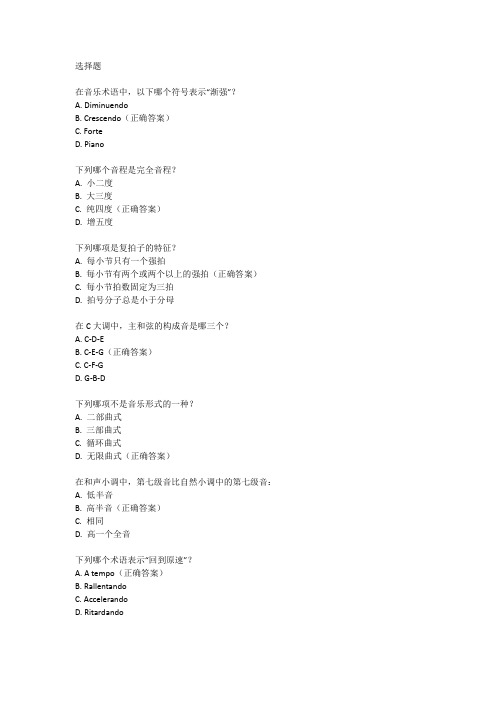
选择题
在音乐术语中,以下哪个符号表示“渐强”?
A. Diminuendo
B. Crescendo(正确答案)
C. Forte
D. Piano
下列哪个音程是完全音程?
A. 小二度
B. 大三度
C. 纯四度(正确答案)
D. 增五度
下列哪项是复拍子的特征?
A. 每小节只有一个强拍
B. 每小节有两个或两个以上的强拍(正确答案)
C. 每小节拍数固定为三拍
D. 拍号分子总是小于分母
在C大调中,主和弦的构成音是哪三个?
A. C-D-E
B. C-E-G(正确答案)
C. C-F-G
D. G-B-D
下列哪项不是音乐形式的一种?
A. 二部曲式
B. 三部曲式
C. 循环曲式
D. 无限曲式(正确答案)
在和声小调中,第七级音比自然小调中的第七级音:
A. 低半音
B. 高半音(正确答案)
C. 相同
D. 高一个全音
下列哪个术语表示“回到原速”?
A. A tempo(正确答案)
B. Rallentando
C. Accelerando
D. Ritardando
在音乐记号中,哪个符号表示“滑音”?
A. >
B. ∧
C. ‾ (上方带弧线的连线)(正确答案)
D. Tr
下列哪个和弦是减三和弦?
A. C-E-G
B. B-D-F#
C. A-C-E∧(正确答案)
D. G-B-D#。
- 1、下载文档前请自行甄别文档内容的完整性,平台不提供额外的编辑、内容补充、找答案等附加服务。
- 2、"仅部分预览"的文档,不可在线预览部分如存在完整性等问题,可反馈申请退款(可完整预览的文档不适用该条件!)。
- 3、如文档侵犯您的权益,请联系客服反馈,我们会尽快为您处理(人工客服工作时间:9:00-18:30)。
S Structure and form; Style and period T Tempo; Texture; Time; Tonality R Rhythm A Articulation D Dynamics
Style and period (character; when the music was composed) Style can also include character or mood. Use words like: piangevole (plaintive) dolce (sweet) pesante (heavy) marcato (accented) agitato (agitated) vivace (lively)
பைடு நூலகம்
Texture (think in terms of thick or thin) Homophonic: chordal, medlody usually in the upper part with chords or broken chords in the lower part Contrapuntal: two or more melodic lines of equal importance combined together Time Number of beats in a bar (2, 3 or 4); simple or compound Tonality major, minor, modal or atonal Rhythm (the pattern of note values) Regular or irregular; describe rhythmic figures (e.g. dotted rhythm, triplets, syncopation) Articulation detached, smooth, accented or ornamented Dynamics (loud/quiet, gradually getting louder/quieter) mf; f; ff; mp; p; pp; crescendo; diminusndo
Here are the main musical periods, with approximate dates: Baroque: 1600-1750 Classical: 1750-1790 Romantic: 1790-1910 Early 20th century: 1910-1940 Contemporary: 1940-now Structure (including phrase structure) (form) Binary (AB) Ternary (ABA) Tempo (speed) performance instructions adagio; moderato; allegro; presto gradually getting faster accrlrtando (accel.); stringerdo (string.) gradually getting slower rallentando (rall.) or ritardando (retard.) in flexible time tempo rubato theme and variations rondo and sonata
